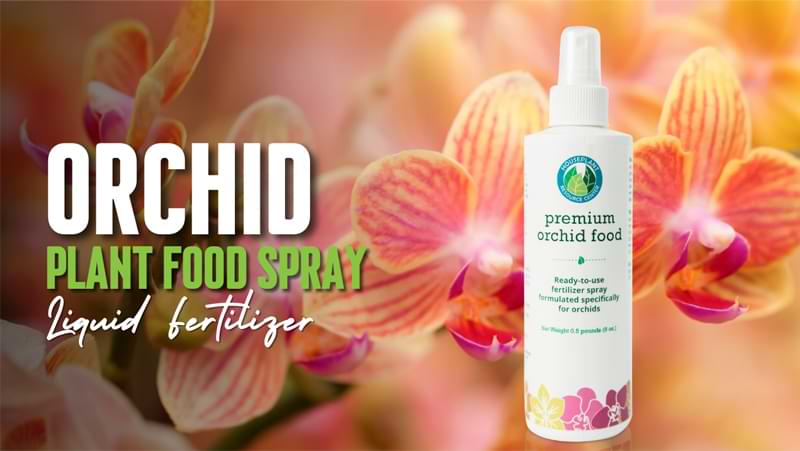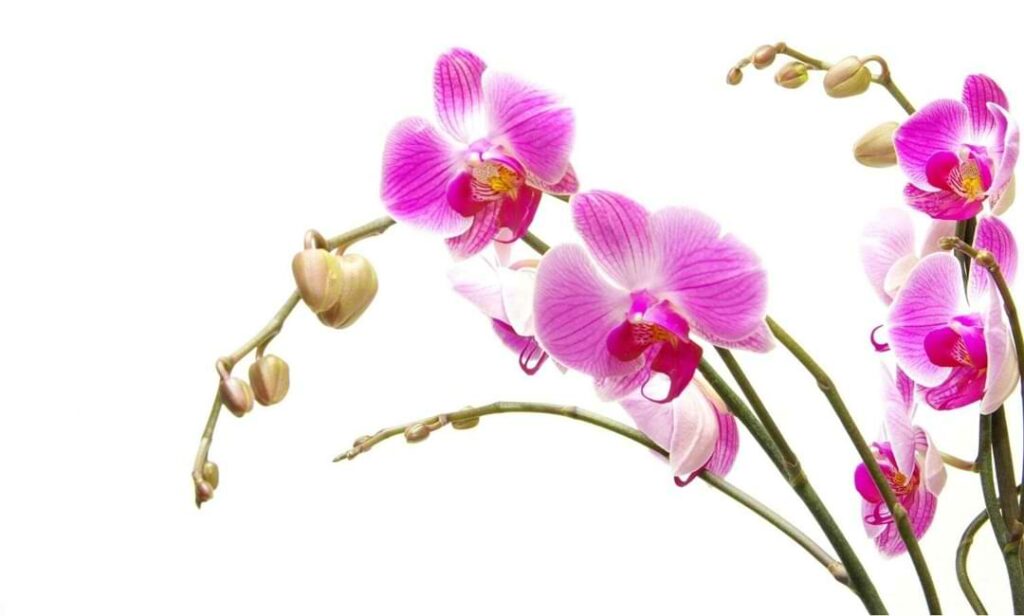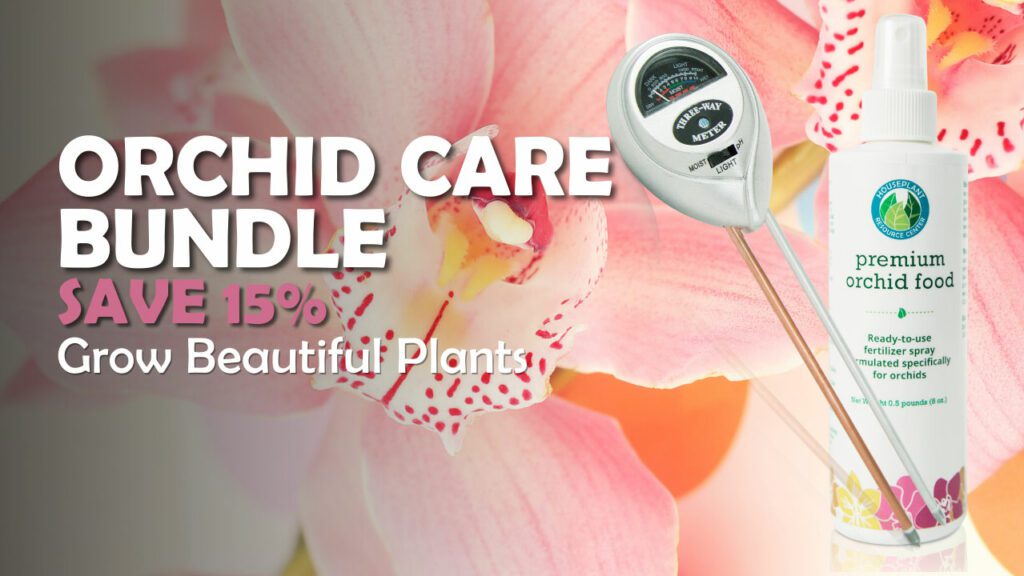Orchids are exotic, stunning plants that make unique additions to any plant collection. They’ve been revered for their intricate shapes, dazzling colors, and big, bountiful blooms for centuries.
And even though orchids have a reputation for being fickle plants that are hard to care for, they can last many, many years if cared for properly.
Just like other plants, orchids need a few simple conditions to thrive. With the right water, sunlight, growing mix, and fertilizer, your orchid will live a long, healthy life and produce iconic blooms for years to come. Typically, orchids live for 20-25 years if grown indoors, though the life span of an orchid plant surely depends on how attentive its grower is and how well it’s cared for.
Let’s dive a little deeper to learn about the orchid’s life cycle, how long its blooms last, and how you can dial in your care routine to keep your orchid a showstopping, thriving plant for years to come.

Are Orchids Annuals or Perennials?
Most common household orchid plants are perennial epiphytes, meaning they flower year over year.
In their natural habitat, orchids grow anchored to trees and shrubs, and they often prefer hot, humid tropical and subtropical climates.
Of course, most homes don’t provide the orchid’s preferred rainforest conditions, so it’s important to follow your orchid’s care instructions to closely replicate its natural growing environment.
To increase the humidity levels in your home, place your orchid on top of a humidity tray. This will increase the moisture levels in the air around your plant and prevent moisture loss from the microscopic pores along your orchid’s stem and leaves.
Another care tip is to avoid placing your orchid next to any heating or air-conditioning vents, as the constantly moving air will negatively affect your plant.
What Is an Orchid’s Life Cycle?
Like all plants, the orchid’s life cycle begins with pollination, a process through which pollen is carried from plant to plant.
In the wild, orchids have a unique relationship with bees, moths, and other insects. Interestingly, orchids have evolved their intricate blooms in the shape of the insect they hope to attract. This encourages a pollinating insect to mistake the orchid for a mate, thus luring it close.
When the insect visits the flower, it quickly realizes it was mistaken, though not before picking up some of the orchid’s pollen. As the insect travels from orchid to orchid, it inadvertently pollinates the plant and perpetuates the reproduction cycle.
One insect can visit hundreds of plants per day, breeding orchids while it flies from flower to flower. In commercial instances, orchids are pollinated manually, sometimes with a fine paintbrush or Q-tip.
When pollen is transferred from one orchid to another, a chemical reaction occurs and the reproduction cycle begins, causing the orchid to develop seed pods. Depending on the orchid species, it may take anywhere from a few weeks to up to 12 months for the seed pods to mature. For example, Disa orchid seeds mature in just six weeks, whereas cattleya orchid seeds spend 12 months maturing.
Once the seed pods are mature, the plant will produce roots and a stem and eventually bloom, kicking off the cycle again.

How Long Do Orchids Live?
Though the exact length of an orchid’s life depends on its species, most orchids typically have a long life span. Some reports estimate orchids can live up to 100 years in the wild, though a life span of 20-25 years is more typical for orchids grown in a traditional home or greenhouse environment.
The key to keeping your orchid happy and healthy for years or even decades is to dial in a care routine that’ll support healthy growth and vibrant blooms.
When you first bring your orchid home, be sure to repot it in a well-draining pot filled with fresh orchid potting mix. Then place your orchid on top of a humidity tray and keep it out of direct sunlight, which can easily burn your plant’s delicate flowers and leaves.
To keep your orchid healthy year-round, use Premium Orchid Food every time you water. The gentle formula is made specifically to support orchid growth and to provide orchids with the nutrients they need to boast green foliage and healthy blooms.

How Long Do Orchids Take to Grow?
Some orchid species are quick to outgrow their pots, while others produce new stems, flowering spikes, and bud much more slowly. Plant growth can also depend on the orchid’s access to proper water, sunlight, and nutrients that support energy-making processes necessary for producing new leaves.
If your orchid has already cycled through at least one bloom season and you want to encourage it to grow, you can place it in a room with bright indirect light and use a gentle orchid fertilizer, such as Premium Orchid Food, that’ll encourage your plant to sprout new buds.
If, on the other hand, you are propagating an orchid from seed, you may need to be patient. Seeds are first grown in a gelatinous substance that contains nutrients and growth hormones. Then they mature before eventually growing into the iconic plants we know and love.
It may take weeks or months for the plant’s first microscopic leaves to develop. Roots appear months later, and it may be five to eight years before the plant is mature enough to produce substantial blooms.
How Often Do Orchids Bloom Indoors?
The frequency and duration of an orchid’s blooms will depend on its species. Some orchid species bloom for a few days, at most, while others show blooms for months at a time. Additionally, some orchid species bloom just once a year, while others cycle through flowering periods two or three times a year.
In addition to the species’ natural bloom seasons and flowering cycles, there are also external factors that can affect your orchid’s ability to produce new buds and blooms, such as temperature and humidity levels.
Most common indoor orchid species, like moth and cymbidium orchids, require a drop in temperature to trigger budding and blooming processes. Other species tend to drop buds if the plant is dehydrated, making the humidity level in your orchid’s environment particularly important to the blooming process.
During your orchid’s blooming season, you can trigger blooms by placing the plant in a cool, dark space overnight. A windowless north-facing room or a basement is a good choice.
Do Orchids Come Back Every Year?
Yes! Orchids are perennial plants that flower year over year. With the proper care, your orchid will boast flowers for a few weeks or months, then go through a necessary dormant period to preserve energy for the next flowering season.
The cycle will continue for the duration of your plant’s life, given it’s healthy and has access to proper care.

How Long Do Orchid Blooms Last?
Depending on the orchid species, blooms can last for a few weeks or up to several months.
Dendrobium orchids typically bloom twice a year, in autumn and winter, while cattleya orchids can bloom more than twice a year with proper care. For both dendrobium and cattleya orchids, flowers stay vibrant for one to two months.
Moth and slipper orchids are two additional species that keep their blooms for months at a time.
What Do You Do With an Orchid After the Blooms Fall Off?
After your orchid drops its blooms, remove the flower spike from the plant with a pair of sharp shears. This will stimulate the plant to grow a new branch and flower spike which will yield new blooms.
Be sure to sterilize the shears to avoid introducing any bacteria to the plant, which may lead to disease or infection. To make a clean, effective cut, choose a location two or three nodes from the plant’s base.

How Long Do Orchids Last? FAQs
Are orchids short-lived?
No! In fact, most orchids are long-living plants, given the proper care and attention. If your orchid dies after only a short time, it likely succumbed to improper care. There are records of divisions or propagations of orchids discovered in the 19th century that are still growing and flowering today.
Are orchids hard to grow?
Contrary to popular belief, orchids are no more difficult to grow than many popular flowering plants. Like all plants, orchids need water, fertilizer, light, and air. If you grow other ornamental plants either in the garden or indoors, you can surely grow orchids, though you’ll want to adjust your care routines to suit epiphytic plants.
Do I need a greenhouse to keep my orchid alive for a long time?
Nope. Many popular orchids can be grown directly in your home or under artificial lights. Most orchids make wonderful table centerpieces or office arrangements.
In tropical and semi-tropical areas, orchids can also be grown in a shady area, in the backyard or hung under a tree. When selecting plants, choose those that will survive in the environment you have to offer or can easily recreate.
What can I do to keep my orchid alive for a long time?
Perhaps the number-one way beginner growers accidentally kill their orchids is by overwatering them. Keep your orchids watered, but never leave them in a wet growing mix. Even a damp growing mix can encourage root rot, so be sure to water your orchids only when they’re thoroughly dry.
A good rule of thumb is to water your orchids no more than once a week, though different orchid types will require adjustments in watering. For most orchid types, you can water even less during the winter months.
For best results, follow this simple rule: When in doubt, don’t water your orchid.
Additionally, avoid placing your orchid in direct sunlight, since direct rays can easily burn the plant. Adjust the window blinds or hang a sheer curtain to diffuse direct sun rays. Place orchids that enjoy bright light in a south- or west-facing window, and place orchids that enjoy low light conditions in an east- or north-facing window.
My orchid hasn’t bloomed in months. Is something wrong with it?
While lack of blooms can be a sign your orchid is in distress, it’s most likely that your orchid hasn’t reached its bloom season yet.
Some species only bloom once a year, and the bloom season for orchids varies by species. A few varieties boast flowers in autumn and winter months, while others only bloom in spring or summer when the weather is warmer.
If you’re not sure when your orchid’s blooming season is, research its type to find out.



